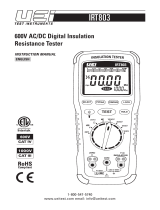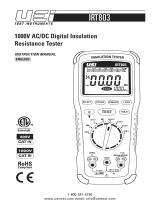
2
Register your product and access more information at
www.idealindustries.com
Read First: Safety Information
Understand and follow operating instructions carefully. Use the meter,
test leads and all accessories only as specified in this manual; otherwise,
the protection provided by the meter can be impaired.
WARNING
To avoid possible electric shock, personal injury or death,
follow these guidelines:
• Do not use if meter appears damaged. Visually inspect the meter to
ensure case and jaws are not cracked.
• Inspect and replace test leads if insulation is damaged, metal is
exposed, or probes are cracked. Pay particular attention to the
insulation surrounding the connectors.
• Always ensure the meter, test leads and all accessories meet or exceed
the measurement category required in the working environment. (i.e.
CAT rating)
• Note that the measurement category and voltage rating of
combinations of the meter, the test leads, and the accessories is the
lowest of the individual components.
• Do not use meter if it operates abnormally as protection maybe
impaired.
• Do not use during electrical storms or in wet weather.
• Do not use around explosive gas, dust, vapor, amperage or in damp or
wet environments.
• Do not apply more than the rated voltage to the meter.
• Remove the test leads from the input jacks before measuring current.
• Replace battery as soon as battery indicator appears to avoid
false readings.
• Remove the test leads from the meter prior to removing battery cover.
• Do not use without the battery and battery cover properly installed.
• Do not attempt to repair this unit as it has no user-serviceable parts.
• Use the proper terminals, functions and range for your measurements.
• Never ground yourself when taking electrical measurements.
• Connect the black common lead to ground or neutral before applying
the red test lead to potential voltage. Disconnect the red test lead from
the voltage first.
• Keep fingers behind the guard rings of the probe tips.
• Voltages exceeding 30VAC or 60VDC pose a shock hazard so use
caution.
























